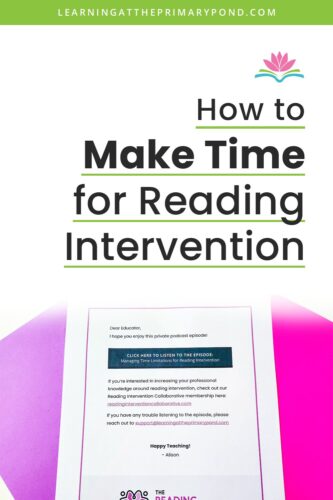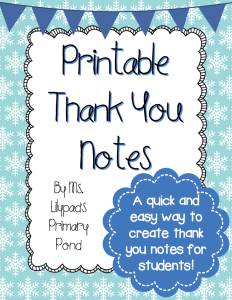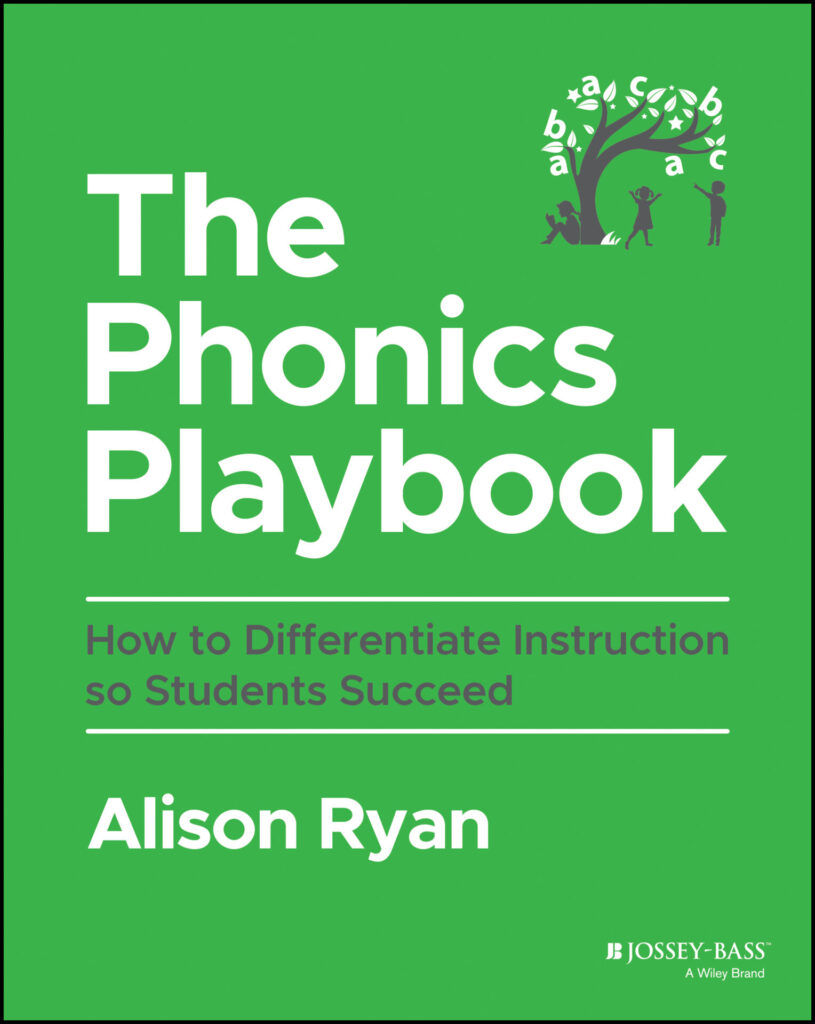In the hustle and bustle of a school day, finding time for reading intervention can feel like a daunting task – especially if you’re a busy classroom teacher. However, ensuring that each student receives the support they need is crucial for their academic success.
This topic really hits home for me! I am someone who hates to feel rushed. I always feel like I would love to have more time available for everything – from teaching reading to students, to working on creating materials, to cooking dinner.
The strategies that I’m going to share with you have really helped me, not only in terms of maximizing the time that I have with my students, but also with my own mental well-being and managing those feelings of being rushed.
Some of these strategies are things I continue to work on and think about on an ongoing basis. I share that because if you ever struggle in this area, you are definitely in good company.
In this blog post, I’ll provide some practical tips on how to make time for reading intervention and also what to do with your reading intervention time!
This topic comes from a free podcast called “Managing Time Limitations for Reading Intervention!” that you can access here.

Although we are going to focus a bit more specifically on reading intervention in this blog, you can still likely apply many of these strategies to any block of time you have available to work with students!
Let’s dive in!
How to Make Time for Reading Intervention
Let’s first focus on how to maximize the amount of minutes available for reading intervention and instruction.
Save time by reflecting on how you gather students for reading intervention.
If you’re a classroom teacher, wrangling your kids might be relatively easy – you just call them over to your small group table. But even then, take a second to reflect on this process.
- Do you have to call them a few times?
- Do you have some who lollygag for a while before making their way over and sitting down?
- When they do sit down, does it take them a bit to get settled?
Sometimes we have these pockets of wasted time that we don’t even realize are happening. If you think time is currently being wasted, you may need to physically usher your students to the table.
Another option is to set a timer and see if they can make it over on their own in “x” number of seconds. Maybe if they beat the timer all week long, they get to play a game (something reading-related, of course!) or they get a little treat from you. Then see if they can beat their time the following week. Eventually, you probably won’t need the timer because they will become so quick at getting over to your table!
If you are a reading interventionist, special education teacher, or ESL teacher, gathering students can be an entirely different ballgame. I once worked in an elementary school that was pretty huge, around 900 kids or so. The building was very spread out, so you could waste some serious time gathering kids. Even if your building isn’t huge, you can still end up losing out on instructional time, depending on what you have to do to round up all of your students.
To help with that, see if it’s possible to have students arrive at your room (assuming you work with students in your own room) at the same time. This way, you don’t have to go door to door. Even if all students are in the same class, it could still be helpful if they simply arrive at your room at the designated time.
If this isn’t an option and you are walking kids through the halls, maybe you could sneak in some phonological awareness practice exercises as you go!
It completely depends on your students, and you could always try things both ways to see which option is faster – as long as it’s okay with teachers and your administrators for kids to be walking alone in the hall.
Become obsessed with organization.
Some people really love the act of organizing. That is not me…! But what I do love is that organization can make life easier and it speeds things up.
This especially applies to intervention. It’s a great idea to use different materials with students, so you can make things multi-sensory, and keep them engaged. But of course, you don’t want to waste any time getting out these materials.
So even if you feel like you’re very organized with your materials, just take a moment to reflect on these questions:
- Are there any materials that take longer to get out or put away?
- Do you find yourself searching for materials or shuffling between different groups’ materials, assuming you see multiple groups?
Consider keeping a bin for each group of students, or even for an individual student if you’re doing one-on-ones. As much as possible goes in that bin.
A set of drawers to organize manipulatives and other materials can be an effective organization tool. If you have a set where you can physically remove the drawers so that students can grab what they need, that can be helpful, too.
Sometimes, it also helps to allow students to take out their own materials – if they’re quick enough about it – so that you can focus on getting other resources ready for the next activity.
Prioritize strong behavior management.
If you’re constantly having to redirect students or tell them what to do, you’re not going to have as much time available for instruction. What really helps me is having nonverbal signals, even just as simple as shaking my head and putting a finger to my lips, to correct behaviors and keep things moving. You might even need to work out a personal signal for a student who is struggling.
If a student really seems to need to talk and get attention from you, give them a leadership role as much as possible, even if it’s just passing out materials. If a student seems resistant to working with you and that’s causing friction, try to build a personal relationship with them outside of reading intervention.
Also, be firm about expectations when it’s time to work. Even if you’re not the student’s classroom teacher, it’s important to take time to go over rules and re-teach expectations throughout the year. Be picky about this, especially at the beginning of the year, and it will ultimately free up more time to work with your kids.
Keep things simple!
Your activities don’t always need to have loads of manipulatives or be wildly different from one day to the next. When you keep your routine simple, it benefits your kids and it saves time. There have been studies done that have shown kids are often more engaged when an instructional routine is simple and straightforward.
Plus, you have to do less instruction on what kids are supposed to be doing. They know the routine, and they can follow it quickly and easily. This builds a sense of security for kids, too. If you want to do something super out of the norm, save it for special occasions or Fridays.
Reflect on how much time you’re spending on each part of the lesson.
Consider if certain parts of your intervention lesson need to be shortened. For example, maybe you’re going through all the flashcards you have for a group of students, but that’s taking up quite a bit of time. As you do this reflection, you may want to go through a lesson like you normally would – without changing anything – and then jot down the time as you finish each activity.
That can really be eye-opening and give you some insight into where you might save a little time so that you can spend it on other activities. I always like to have a digital clock with large numbers near where I’m doing reading intervention to see exactly what time it is and how much time we have left.
What to Do with Your Reading Intervention Time
The strategies that I’ve described so far can probably buy you a few minutes to add to your reading intervention time. But where you get the real time savings is really not from adding on a few seconds here and there. It actually comes from optimizing the time that you do have with your students.
Focus on a maximum of three foundational skills.
One thing that’s really hard about teaching reading is that there are so many components to it. There’s phonics, fluency, and comprehension. Even within those categories, there is complexity.
If we’re thinking about classroom instruction, we want to make sure that we are addressing all of these areas. But when it comes to reading intervention specifically, the research has indicated that it is most effective to focus on just a few (up to three) foundational skill areas.
Read more about how to identify which areas to focus on in this blog: “Find the Why (This Will Support Your Struggling Readers!)”
You can also think about choosing an activity that allows for multiple skills to be covered. For instance, if a child needs to work on decoding multisyllabic words and comprehension, pick texts with multisyllabic words. Have them decode a few words from the text before they read it, and then you can work on comprehension after they read.
Minimize the “teacher talk.”
“Teacher talk” is, simply, what you say to students. To reflect on how much teacher talk you use, consider using your phone to audio record yourself as you teach. Personally, it is so easy for me to ramble, and repeat things too much, rather than just getting to the point and stating things clearly. (I’m always working on improving this!)
If you find that you aren’t being as concise as you could be, you might want to take the time to script out a few important pieces of your lessons ahead of time.
So for example, instead of saying:
“Are you finished building the word? Let’s see… can you put your finger under the first letter? I’m waiting for everyone to be ready… Let’s say the sounds together. Ready?“
…you might just say:
“Put your finger under the first letter so we can sound out the word. Ready?”
Not only does this actually save a few seconds, but it helps students better understand what you’re saying. Part of explicit instruction is clear, direct explanations from the teacher.
Get creative with the time that students have outside of reading intervention.
We all know that, in most schools, kids who are struggling simply don’t get enough extra help. Period.
No matter how good and organized you are with your instruction, the minutes you need often literally just aren’t available. So this last strategy is to get creative with the time that students spend outside of reading intervention. Here are a couple of ideas:
- Ask students to reread a passage at home that they’ve already built fluency with during reading intervention.
- Have students practice reading a few words on cards or a list when they’re at home. (I try to send a letter of explanation, but I always tell the kids that they can practice even without an adult – perhaps by reading to a stuffed animal, sibling, or pet!)
- If you’re an interventionist, special education teacher, or ESL teacher, always collaborate with the child’s classroom teacher so you’re all on the same page. Ask them if there are times during the school day, like literacy centers, where the student could benefit from having reading materials at their level. You can send a book or passage from reading intervention for the child to re-read during centers time.
Shifting Your Mindset Around Time
Have you ever had any of the following thoughts around reading instruction?
- “I’m running out of time.”
- “I won’t have enough time.”
- “There’s never enough time.”
- “I know I could get this kid to make more progress, if I only had more time.”
Our thoughts contribute directly to our feelings. So if you are having thoughts like these, it’s pretty likely that they are causing you to stress, to feel pressure, to rush around, or to feel like you’re lacking.
Those aren’t good feelings. Not only are they not good feelings, but they can actually impact your teaching. Just think about who’s better and more focused – a teacher who is super stressed, or a teacher who is more relaxed? Usually, the more relaxed teacher is able to be mentally and emotionally present with their students.
Shift your thoughts.
Time can feel like such a concrete, unchangeable thing. We have “x” number of minutes for doing reading intervention, and that’s it. But something that IS changeable is the set of thoughts we have around time.
What if you replaced those thoughts of “I need more time” with “I have all the time I need” or “I make the most of the time I have.”
This doesn’t happen magically or overnight – you have to monitor and correct yourself as you notice these negative thoughts around time popping up in your everyday life, both at school and at home. And if you change your thoughts around time, you just might change your feelings and your stress levels, too.
Question the accuracy of your thoughts.
Just because we have a thought that pops into our head does not make it true! For instance, if you’re thinking, “I don’t have enough time with this group,” question that. Ask yourself, “What if I had two hours a day with them? Is it possible that I’d still feel like I could use more time?” (The answer to that is probably yes, by the way!) Or ask yourself, “Isn’t it still possible to help them make great progress, even with limited time?”
Taking another look at your thoughts – about time or any topic – can be a really helpful way to get yourself out of a thought rut that might be causing you stress on a daily basis.
Conclusion
These are a lot of suggestions, so even if you’d like to try a number of them, it might be best to first just pick a few to tackle first. If you want to review this information and listen to it in an audio format, click here for my free podcast version!
Please let me know if you have any questions about anything I’ve shared here! If you want to save this post for later, here’s an image you can pin to your Pinterest account:

Happy teaching!












